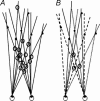Colour helps to solve the binocular matching problem
- PMID: 15975983
- PMCID: PMC1474183
- DOI: 10.1113/jphysiol.2005.089516
Colour helps to solve the binocular matching problem
Abstract
The spatial differences between the two retinal images, called binocular disparities, can be used to recover the three-dimensional (3D) aspects of a scene. The computation of disparity depends upon the correct identification of corresponding features in the two images. Understanding what image features are used by the brain to solve this binocular matching problem is an important issue in research on stereoscopic vision. The role of colour in binocular vision is controversial and it has been argued that colour is ineffective in achieving binocular vision. In the current experiment subjects were required to indicate the amount of perceived depth. The stimulus consisted of an array of fronto-parallel bars uniformly distributed in a constant sized volume. We studied the perceived depth in those 3D stimuli by manipulating both colour (monochrome, trichrome) and luminance (congruent, incongruent). Our results demonstrate that the amount of perceived depth was influenced by colour, indicating that the visual system uses colour to achieve binocular matching. Physiological data have revealed cortical cells in macaque V2 that are tuned both to binocular disparity and to colour. We suggest that one of the functional roles of these cells may be to help solve the binocular matching problem.
Figures




Similar articles
-
Motion direction, speed and orientation in binocular matching.Nature. 2001 Apr 5;410(6829):690-4. doi: 10.1038/35070569. Nature. 2001. PMID: 11287955
-
A new look at binocular stereopsis.Vision Res. 2005 Aug;45(17):2244-55. doi: 10.1016/j.visres.2005.02.011. Epub 2005 Mar 17. Vision Res. 2005. PMID: 15924939
-
Responses of primary visual cortical neurons to binocular disparity without depth perception.Nature. 1997 Sep 18;389(6648):280-3. doi: 10.1038/38487. Nature. 1997. PMID: 9305841
-
The role of monocularly visible regions in depth and surface perception.Vision Res. 2009 Nov;49(22):2666-85. doi: 10.1016/j.visres.2009.06.021. Epub 2009 Jul 3. Vision Res. 2009. PMID: 19577589 Review.
-
Binocular correspondence in stereoscopic vision.Eye (Lond). 1996;10 ( Pt 2):177-81. doi: 10.1038/eye.1996.44. Eye (Lond). 1996. PMID: 8776446 Review. No abstract available.
Cited by
-
Client-Oriented Blind Quality Metric for High Dynamic Range Stereoscopic Omnidirectional Vision Systems.Sensors (Basel). 2022 Nov 4;22(21):8513. doi: 10.3390/s22218513. Sensors (Basel). 2022. PMID: 36366211 Free PMC article.
-
Illusory colors promote interocular grouping during binocular rivalry.Psychon Bull Rev. 2007 Apr;14(2):356-62. doi: 10.3758/bf03194077. Psychon Bull Rev. 2007. PMID: 17694926
-
Focus information is used to interpret binocular images.J Vis. 2010 May 1;10(5):13. doi: 10.1167/10.5.13. J Vis. 2010. PMID: 20616139 Free PMC article.
-
Mechanisms for similarity matching in disparity measurement.Front Psychol. 2014 Jan 8;4:1014. doi: 10.3389/fpsyg.2013.01014. eCollection 2014. Front Psychol. 2014. PMID: 24409163 Free PMC article.
-
The influence of stereopsis on visual saliency in a proto-object based model of selective attention.Vision Res. 2023 Nov;212:108304. doi: 10.1016/j.visres.2023.108304. Epub 2023 Aug 3. Vision Res. 2023. PMID: 37542763 Free PMC article.
References
-
- Comerford JP. Stereopsis with chromatic contours. Vision Res. 1974;14:975–982. - PubMed
-
- Cumming BG, DeAngelis GC. The physiology of stereopsis. Annu Rev Neurosci. 2001;24:203–238. - PubMed
-
- de Weert CMM, Sadza KJ. New data concerning the contribution of colour differences to stereopsis. In: Mollon JD, Sharpe LT, editors. In Colour Vision: Physiology and psychophysics. London: Academic Press; 1983. pp. 553–562.
-
- Domini F, Blaser E, Cicerone CM. Color-specific depth mechanisms revealed by a color-contingent depth aftereffect. Vision Res. 2000;40:359–364. - PubMed
-
- Gegenfurtner KR, Hawken MJ. Interaction of motion and color in the visual pathways. Trends Neurosci. 1996;19:394–401. - PubMed
Publication types
MeSH terms
LinkOut - more resources
Full Text Sources

